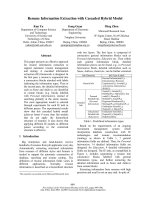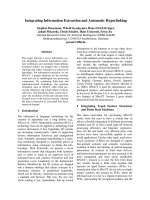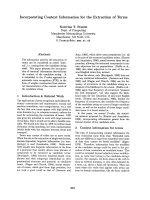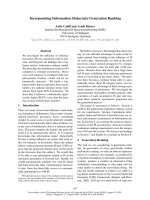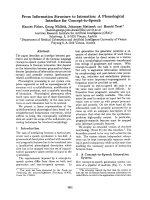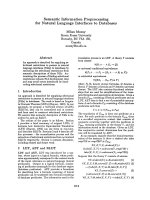Báo cáo khoa học: "Incorporating Information Status into Generation Ranking" pptx
Bạn đang xem bản rút gọn của tài liệu. Xem và tải ngay bản đầy đủ của tài liệu tại đây (140.14 KB, 9 trang )
Proceedings of the 47th Annual Meeting of the ACL and the 4th IJCNLP of the AFNLP, pages 817–825,
Suntec, Singapore, 2-7 August 2009.
c
2009 ACL and AFNLP
Incorporating Information Status into Generation Ranking
Aoife Cahill and Arndt Riester
Institut f
¨
ur Maschinelle Sprachverarbeitung (IMS)
University of Stuttgart
70174 Stuttgart, Germany
{aoife.cahill,arndt.riester}@ims.uni-stuttgart.de
Abstract
We investigate the influence of informa-
tion status (IS) on constituent order in Ger-
man, and integrate our findings into a log-
linear surface realisation ranking model.
We show that the distribution of pairs of IS
categories is strongly asymmetric. More-
over, each category is correlated with mor-
phosyntactic features, which can be au-
tomatically detected. We build a log-
linear model that incorporates these asym-
metries for ranking German string reali-
sations from input LFG F-structures. We
show that it achieves a statistically signif-
icantly higher BLEU score than the base-
line system without these features.
1 Introduction
There are many factors that influence word order,
e.g. humanness, definiteness, linear order of gram-
matical functions, givenness, focus, constituent
weight. In some cases, it can be relatively straight-
forward to automatically detect these features (i.e.
in the case of definiteness, this is a syntactic prop-
erty). The more complex the feature, the more dif-
ficult it is to automatically detect. It is common
knowledge that information status
1
(henceforth,
IS) has a strong influence on syntax and word or-
der; for instance, in inversions, where the subject
follows some preposed element, Birner (1994) re-
ports that the preposed element must not be newer
in the discourse than the subject. We would like
to be able to use information related to IS in the
automatic generation of German text. Ideally, we
would automatically annotate text with IS labels
and learn from this data. Unfortunately, however,
to date, there has been little success in automati-
cally annotating text with IS.
1
We take information status to be a subarea of information
structure; the one dealing with varieties of givenness but not
with contrast and focus in the strictest sense.
We believe, however, that despite this shortcom-
ing, we can still take advantage of some of the in-
sights gained from looking at the influence of IS
on word order. Specifically, we look at the prob-
lem from a more general perspective by comput-
ing an asymmetry ratio for each pair of IS cate-
gories. Results show that there are a large num-
ber of pairs exhibiting clear ordering preferences
when co-occurring in the same clause. The ques-
tion then becomes, without being able to auto-
matically detect these IS category pairs, can we,
nevertheless, take advantage of these strong asym-
metric patterns in generation. We investigate the
(automatically detectable) morphosyntactic char-
acteristics of each asymmetric IS pair and inte-
grate these syntactic asymmetric properties into
the generation process.
The paper is structured as follows: Section 2
outlines the underlying realisation ranking system
for our experiments. Section 3 introduces infor-
mation status and Section 4 describes how we ex-
tract and measure asymmetries in information sta-
tus. In Section 5, we examine the syntactic charac-
teristics of the IS asymmetries. Section 6 outlines
realisation ranking experiments to test the integra-
tion of IS into the system. We discuss our findings
in Section 7 and finally we conclude in Section 8.
2 Generation Ranking
The task we are considering is generation rank-
ing. In generation (or more specifically, surface
realisation) ranking, we take an abstract represen-
tation of a sentence (for example, as produced by
a machine translation or automatic summarisation
system), produce a number of alternative string
realisations corresponding to that input and use
some model to choose the most likely string. We
take the model outlined in Cahill et al. (2007), a
log-linear model based on the Lexical Functional
Grammar (LFG) Framework (Kaplan and Bres-
nan, 1982). LFG has two main levels of represen-
817
CS 1:
ROOT:1458
CProot[std]:1451
DP[std]:906
DPx[std]:903
D[std]:593
die:34
NP:738
N[comm]:693
Behörden:85
Cbar:1448
Cbar-flat:1436
V[v,fin]:976
Vx[v,fin]:973
warnten:117
PP[std]:2081
PPx[std]:2072
P[pre]:1013
vor:154
DP[std]:1894
DPx[std]:1956
NP:1952
AP[std,+infl]:1946
APx[std,+infl]:1928
A[+infl]:1039
möglichen:185
N[comm]:1252
Nachbeben:263
PERIOD:397
.:389
"Die Behörden warnten vor möglichen Nachbeben."
'warnen<[34:Behörde], [263:Nachbeben]>'PRED
'Behörde'PRED
'die'PRED
DETSPEC
CASE nom, NUM pl, PERS 3
34
SUBJ
'vor<[263:Nachbeben]>'PRED
'Nachbeben'PRED
'möglich<[263:Nachbeben]>'PRED
[263:Nachbeben]SUBJ
attributiveATYPE
185
ADJUNCT
CASE dat, NUM pl, PERS 3
263
OBJ
154
OBL
MOOD indicative, TENSE past
TNS-ASP
[34:Behörde]TOPIC
117
Figure 1: An example C(onstituent) and F(unctional) Structure pair for (1)
tation, C(onstituent)-Structure and F(unctional)-
Structure. C-Structure is a context-free tree rep-
resentation that captures characteristics of the sur-
face string while F-Structure is an abstract repre-
sentation of the basic predicate-argument structure
of the string. An example C- and F-Structure pair
for the sentence in (1) is given in Figure 1.
(1) Die
the
Beh
¨
orden
authorities
warnten
warned
vor
of
m
¨
oglichen
possible
Nachbeben.
aftershocks
‘The authorities warned of possible aftershocks.’
The input to the generation system is an F-
Structure. A hand-crafted, bi-directional LFG of
German (Rohrer and Forst, 2006) is used to gener-
ate all possible strings (licensed by the grammar)
for this input. As the grammar is hand-crafted,
it is designed only to parse (and therefore) gen-
erate grammatical strings.
2
The task of the reali-
sation ranking system is then to choose the most
likely string. Cahill et al. (2007) describe a log-
linear model that uses linguistically motivated fea-
tures and improves over a simple tri-gram lan-
guage model baseline. We take this log-linear
model as our starting point.
3
2
There are some rare instances of the grammar parsing
and therefore also generating ungrammatical output.
3
Forst (2007) presents a model for parse disambiguation
that incorporates features such as humanness, definiteness,
linear order of grammatical functions, constituent weight.
Many of these features are already present in the Cahill et
al. (2007) model.
An error analysis of the output of that system
revealed that sometimes “unnatural” outputs were
being selected as most probable, and that often
information structural effects were the cause of
subtle differences in possible alternatives. For
instance, Example (3) appeared in the original
TIGER corpus with the 2 preceding sentences (2).
(2) Denn ausdr
¨
ucklich ist darin der rechtliche Maßstab
der Vorinstanz, des S
¨
achsischen Oberverwaltungs-
gerichtes, best
¨
atigt worden. Und der besagt: Die
Beteiligung am politischen Strafrecht der DDR, der
Mangel an kritischer Auseinandersetzung mit to-
talit
¨
aren
¨
Uberzeugungen rechtfertigen den Ausschluss
von der Dritten Gewalt.
‘Because, the legal benchmark has explicitly been con-
firmed by the lower instance, the Saxonian Higher Ad-
ministrative Court. And it indicates: the participation
in the political criminal law of the GDR as well as
deficits regarding the critical debate on totalitarian con-
victions justify an expulsion from the judiciary.’
(3) Man
one
hat
has
aus
out of
der
the
Vergangenheitsaufarbeitung
coming to terms with the past
gelernt.
learnt
‘People have learnt from dealing with the past mis-
takes.’
The five alternatives output by the grammar are:
a. Man hat aus der Vergangenheitsaufarbeitung gelernt.
b. Aus der Vergangenheitsaufarbeitung hat man gelernt.
c. Aus der Vergangenheitsaufarbeitung gelernt hat man.
d. Gelernt hat man aus der Vergangenheitsaufarbeitung.
e. Gelernt hat aus der Vergangenheitsaufarbeitung man.
818
The string chosen as most likely by the system of
Cahill et al. (2007) is Alternative (b). No mat-
ter whether the context in (2) is available or the
sentence is presented without any context, there
seems to be a preference by native speakers for
the original string (a). Alternative (e) is extremely
marked
4
to the point of being ungrammatical. Al-
ternative (c) is also very marked and so is Alterna-
tive (d), although less so than (c) and (e). Alter-
native (b) is a little more marked than the original
string, but it is easier to imagine a preceding con-
text where this sentence would be perfectly appro-
priate. Such a context would be, e.g. (4).
(4) Vergangenheitsaufarbeitung und Abwiegeln sind zwei
sehr unterschiedliche Arten, mit dem Geschehenen
umzugehen.
‘Dealing with the mistakes or playing them down are
two very different ways to handle the past.’
If we limit ourselves to single sentences, the
task for the model is then to choose the string that
is closest to the “default” expected word order (i.e.
appropriate in the most number of contexts). In
this work, we concentrate on integrating insights
from work on information status into the realisa-
tion ranking process.
3 Information Status
The concept of information status (Prince, 1981;
Prince, 1992) involves classifying NP/PP/DP ex-
pressions in texts according to various ways of
their being given or new. It replaces and specifies
more clearly the often vaguely used term given-
ness. The process of labelling a corpus for IS can
be seen as a means of discourse analysis. Different
classification systems have been proposed in the
literature; see Riester (2008a) for a comparison of
several IS labelling schemes and Riester (2008b)
for a new proposal based on criteria from presup-
position theory. In the work described here, we
use the scheme of Riester (2008b). His main theo-
retic assumption is that IS categories (for definites)
should group expressions according to the contex-
tual resources in which their presuppositions find
an antecedent. For definites, the set of main cate-
gory labels found in Table 1 is assumed.
The idea of resolution contexts derives from
the concept of a presupposition trigger (e.g. a
definite description) as potentially establishing an
4
By marked, we mean that there are relatively few or spe-
cialised contexts in which this sentence is acceptable.
Context resource IS label
discourse D-GIVEN
context
encyclopedic/ ACCESSIBLE-GENERAL
knowledge
context
environment/ SITUATIVE
situative
context
bridging BRIDGING
context (scenario)
accommodation ACCESSIBLE-
(no context) DESCRIPTION
Table 1: IS classification for definites
anaphoric relation (van der Sandt, 1992) to an en-
tity being available by some means or other. But
there are some expressions whose referent cannot
be identified and needs to be accommodated, com-
pare (5).
(5) [die monatelange F
¨
uhrungskrise der Hamburger
Sozialdemokraten]
ACC-DESC
‘the leadership crisis lasting for months among the
Hamburg Social Democrats’
Examples like this one have been mentioned
early on in the literature (e.g. Hawkins (1978),
Clark and Marshall (1981)). Nevertheless, label-
ing schemes so far have neglected this issue, which
is explicitly incorporated in the system of Riester
(2008b).
The status of an expression is ACCESSIBLE-
GENERAL (or unused, following Prince (1981))
if it is not present in the previous discourse but
refers to an entity that is known to the intended
recipent. There is a further differentiation of the
ACCESSIBLE-GENERAL class into generic (TYPE)
and non-generic (TOKEN) items.
An expression is D-GIVEN (or textually evoked)
if and only if an antecedent is available in the
discourse context. D-GIVEN entities are subdi-
vided according to whether they are repetitions of
their antecedent, short forms thereof, pronouns or
whether they use new linguistic material to add in-
formation about an already existing discourse ref-
erent (label: EPITHET). Examples representing a
co-reference chain are shown in (6).
(6) [Angela Merkel]
ACC-GEN
(first mention) . . . [An-
gela Merkel]
D-GIV-REPEATED
(second mention) . . .
[Merkel]
D-GIV-SHORT
. . . [she]
D-GIV-PRONOUN
. . .
[herself]
D-GIV-REFLEXIVE
. . . [the Hamburg-born
politician]
D-GIV-EPITHET
Indexicals (referring to entities in the environ-
ment context) are labeled as SITUATIVE. Definite
819
items that can be identified within a scenario con-
text evoked by a non-coreferential item receive the
label BRIDGING; compare Example (7).
(7) In
in
Sri Lanka
Sri Lanka
haben
have
tamilische
Tamil
Rebellen
rebels
erstmals
for the first time
einen
an
Luftangriff
airstrike
[gegen
against
die
the
Streitkr
¨
afte]
BRIDG
armed forces
geflogen.
flown.
’In Sri Lanka, Tamil rebels have, for the first time, car-
ried out an airstrike against the armed forces.’
In the indefinite domain, a simple classification
along the lines of Table 2 is proposed.
Type IS label
unrelated to context NEW
part-whole relation PARTITIVE
to previous entity
other (unspecified) INDEF-REL
relation to context
Table 2: IS classification for indefinites
There are a few more subdivisions. Table 3,
for instance, contains the labels BRIDGING-CON-
TAINED and PARTITIVE-CONTAINED, going back
to Prince’s (1981:236) “containing inferrables”.
The entire IS label inventory used in this study
comprises 19 (sub)classes in total.
4 Asymmetries in IS
In order to find out whether IS categories are un-
evenly distributed within German sentences we
examine a corpus of German radio news bulletins
that has been manually annotated for IS (496 an-
notated sentences in total) using the scheme of
Riester (2008b).
5
For each pair of IS labels X and Y we count
how often they co-occur in the corpus within a sin-
gle clause. In doing so, we distinguish the num-
bers for “X preceding Y ” (= A) and “Y preceding
X” (= B). The larger group is referred to as the
dominant order. Subsequently, we compute a ratio
indicating the degree of asymmetry between the
two orders. If, for instance, the dominant pattern
occurs 20 times (A) and the reverse pattern only 5
times (B), the asymmetry ratio B/A is 0.25.
6
5
The corpus was labeled by two independent annotators
and the results were compared by a third person who took
the final decision in case of disagreement. An evaluation as
regards inter-coder agreement is currently underway.
6
Even if some of the sentences we are learning from are
marked in terms of word order, the ratios allow us to still learn
the predominant order, since the marked order should occur
much less frequently and the ratio will remain low.
Dominant order (: “before”) B/A Total
D-GIV-PROINDEF-REL 0 19
D-GIV-PROD-GIV-CAT 0.1 11
D-GIV-RELNEW 0.11 31
D-GIV-PROSIT 0.13 17
ACC-DESCINDEF-REL 0.14 24
ACC-DESCACC-GEN-TY 0.19 19
D-GIV-EPIINDEF-REL 0.2 12
D-GIV-REPNEW 0.21 23
D-GIV-PROACC-GEN-TY 0.22 11
ACC-GEN-TO ACC-GEN-TY 0.24 42
D-GIV-PROACC-DESC 0.24 46
EXPLNEW 0.25 30
D-GIV-RELD-GIV-EPI 0.25 15
BRIDG-CONTPART-CONT 0.25 15
ACC-DESCEXPL 0.29 27
D-GIV-PROD-GIV-REP 0.29 18
D-GIV-PRONEW 0.29 88
D-GIV-RELACC-DESC 0.3 26
SITEXPL 0.31 17
D-GIV-PROBRIDG-CONT 0.31 21
D-GIV-PROD-GIV-SHORT 0.32 29
. . . . . .
ACC-DESCACC-GEN-TO 0.91 201
SITBRIDG 0.92 23
EXPLACC-DESC 1 12
Table 3: Asymmetric pairs of IS labels
Table 3 gives the top asymmetry pairs down to
a ratio of about 1:3 as well as, down at the bottom,
the pairs that are most evenly distributed. This
means that the top pairs exhibit strong ordering
preferences and are, hence, unevenly distributed
in German sentences. For instance, the ordering
D-GIVEN-PRONOUN before INDEF-REL (top line),
shown in Example (8), occurs 19 times in the ex-
amined corpus while there is no example in the
corpus for the reverse order.
7
(8) [Sie]
D-GIV-PRO
she
w
¨
urde
would
auch
also
[bei
at
verringerter
reduced
Anzahl]
INDEF-REL
number
jede
every
vern
¨
unftige
sensible
Verteidigungsplanung
defence planning
sprengen.
blast
‘Even if the numbers were reduced it would blow every
sensible defence planning out of proportion.’
5 Syntactic IS Asymmetries
It seems that IS could, in principle, be quite bene-
ficial in the generation ranking task. The problem,
of course, is that we do not possess any reliable
system of automatically assigning IS labels to un-
known text and manual annotations are costly and
time-consuming. As a substitute, we identify a list
7
Note that we are not claiming that the reverse pattern is
ungrammatical or impossible, we just observe that it is ex-
tremely infrequent.
820
of morphosyntactic characteristics that the expres-
sions can adopt and investigate how these are cor-
related to our inventory of IS categories.
For some IS labels there is a direct link between
the typical phrases that fall into that IS category,
and the syntactic features that describe it. One
such example is D -GIVEN-PR ONOUN, which al-
ways corresponds to a pronoun, or EXPL which
always corresponds to expletive items. Such syn-
tactic markers can easily be identified in the LFG
F-structures. On the other hand, there are many
IS labels for which there is no clear cut syntac-
tic class that describes its typical phrases. Ex-
amples include NEW, ACCESSIBLE-GENERAL or
ACCESSIBLE-DESCRIPTION.
In order to determine whether we can ascertain
a set of syntactic features that are representative
of a particular IS label, we design an inventory of
syntactic features that are found in all types of IS
phrases. The complete inventory is given in Table
5. It is a much easier task to identify these syntac-
tic characteristics than to try and automatically de-
tect IS labels directly, which would require a deep
semantic understanding of the text. We automati-
cally mark up the news corpus with these syntactic
characteristics, giving us a corpus both annotated
for IS and syntactic features.
We can now identify, for each IS label, what the
most frequent syntactic characteristics of that la-
bel are. Some examples and their frequencies are
given in Table 4.
Syntactic feature Count
D-GIVEN-PRONOUN
PERS PRON 39
DA PRON 25
DEMON PRON 19
GENERIC PRON 11
NEW
SIMPLE INDEF 113
INDEF ATTR 53
INDEF NUM 32
INDEF PPADJ 26
INDEF GEN 25
. . .
Table 4: Syntactic characteristics of IS labels
Combining the most frequent syntactic charac-
teristics with the asymmetries presented in Table 3
gives us Table 6.
8
8
For reasons of space, we are only showing the very top
of the table.
6 Generation Ranking Experiments
Using the augmented set of IS asymmetries,
we design new features to be included into the
original model of Cahill et al. (2007). For each
IS asymmetry, we extract all precedence patterns
of the corresponding syntactic features. For
example, from the first asymmetry in Table 6, we
extract the following features:
PERS
PRON precedes INDEF ATTR
PERS PRON precedes SIMPLE INDEF
DA PRON precedes INDEF ATTR
DA PRON precedes SIMPLE INDEF
DEMON PRON precedes INDEF ATTR
DEMON PRON precedes SIMPLE INDEF
GENERIC PRON precedes INDEF ATTR
GENERIC PRON precedes SIMPLE INDEF
We extract these patterns for all of the asym-
metric pairs in Table 3 (augmented with syntac-
tic characteristics) that have a ratio >0.4. The
patterns we extract need to be checked for incon-
sistencies because not all of them are valid. By
inconsistencies, we mean patterns of the type X
precedes X, Y precedes Y, and any pat-
tern where the variant X precedes Y as well
as Y precedes X is present. These are all auto-
matically removed from the list of features to give
a total of 130 new features for the log-linear rank-
ing model.
We train the log-linear ranking model on 7759
F-structures from the TIGER treebank. We gen-
erate strings from each F-structure and take the
original treebank string to be the labelled exam-
ple. All other examples are viewed as unlabelled.
We tune the parameters of the log-linear model on
a small development set of 63 sentences, and carry
out the final evaluation on 261 unseen sentences.
The ranking results of the model with the addi-
tional IS-inspired features are given in Table 7.
Exact
Model BLEU Match
(%)
Cahill et al. (2007) 0.7366 52.49
New Model (Model 1) 0.7534 54.40
Table 7: Ranking Results for new model with IS-
inspired syntactic asymmetry features.
We evaluate the string chosen by the log-linear
model against the original treebank string in terms
of exact match and BLEU score (Papineni et al.,
821
Syntactic feature Type
Definites
Definite descriptions
SIMPLE DEF simple definite descriptions
POSS DEF simple definite descriptions with a possessive determiner
(pronoun or possibly genitive name)
DEF ATTR ADJ definite descriptions with adjectival modifier
DEF GENARG definite descriptions with a genitive argument
DEF PPADJ definite descriptions with a PP adjunct
DEF RELARG definite descriptions including a relative clause
DEF APP definite descriptions including a title or job description
as well as a proper name (e.g. an apposition)
Names
PROPER combinations of position/title and proper name (without article)
BARE PROPER bare proper names
Demonstrative descriptions
SIMPLE DEMON simple demonstrative descriptions
MOD DEMON adjectivally modified demonstrative descriptions
Pronouns
PERS PRON personal pronouns
EXPL PRON expletive pronoun
REFL PRON reflexive pronoun
DEMON PRON demonstrative pronouns (not: determiners)
GENERIC PRON generic pronoun (man – one)
DA PRON ”da”-pronouns (darauf, dar
¨
uber, dazu, . . . )
LOC ADV location-referring pronouns
TEMP ADV,YEAR Dates and times
Indefinites
SIMPLE INDEF simple indefinites
NEG INDEF negative indefinites
INDEF ATTR
indefinites with adjectival modifiers
INDEF CONTRAST indefinites with contrastive modifiers
(einige – some, andere – other, weitere – further, . . . )
INDEF PPADJ indefinites with PP adjuncts
INDEF REL indefinites with relative clause adjunct
INDEF GEN indefinites with genitive adjuncts
INDEF NUM measure/number phrases
INDEF QUANT quantified indefinites
Table 5: An inventory of interesting syntactic characteristics in IS phrases
Label 1 (+ features) Label 2 (+ features) B/A Total
D-GIVEN-PRONOUN
INDEF-REL 0 19
PERS PRON 39 INDEF ATTR 23
DA PRON 25 SIMPLE INDEF 17
DEMON PRON 19
GENERIC PRON 11
D-GIVEN-PRONOUN
D-GIVEN-CATAPHOR 0.1 11
PERS PRON 39 SIMPLE DEF 13
DA PRON 25 DA PRON 10
DEMON PRON 19
GENERIC PRON 11
D-GIVEN-REFLEXIVE
NEW 0.11 31
REFL PRON 54 SIMPLE INDEF 113
INDEF ATTR 53
INDEF NUM 32
INDEF PPADJ 26
INDEF GEN 25
Table 6: IS asymmetric pairs augmented with syntactic characteristics
822
2002). We achieve an improvement of 0.0168
BLEU points and 1.91 percentage points in exact
match. The improvement in BLEU is statistically
significant (p < 0.01) using the paired bootstrap
resampling significance test (Koehn, 2004).
Going back to Example (3), the new model
chooses a “better” string than the Cahill et al.
(2007) model. The new model chooses the orig-
inal string. While the string chosen by the Cahill
et al. (2007) system is also a perfectly valid sen-
tence, our empirical findings from the news corpus
were that the default order of generic pronoun be-
fore definite NP were more frequent. The system
with the new features helped to choose the original
string, as it had learnt this asymmetry.
Was it just the syntax?
The results in Table 7 clearly show that the new
model is beneficial. However, we want to know
how much of the improvement gained is due to
the IS asymmetries, and how much the syntactic
asymmetries on their own can contribute. To this
end, we carry out a further experiment where we
calculate syntactic asymmetries based on the au-
tomatic markup of the corpus, and ignore the IS
labels completely. Again we remove any incon-
sistent asymmetries and only choose asymmetries
with a ratio of higher than 0.4. The top asymme-
tries are given in Table 8.
Dominant order (: “before”) B/A Total
BAREPROPERINDEF NUM 0 33
DA PRONINDEF NUM 0 16
DEF PPADJTEMP ADV 0 15
SIMPLE INDEFINDEF QUANT 0 14
PERS PRONINDEF ATTR 0 12
DEF PPADJEXPL PRON 0 12
GENERIC PRONINDEF ATTR 0 12
REFL PRONYEAR 0 11
INDEF PPADJINDEF NUM 0.02 57
DEF APPBAREPROPER 0.03 34
BAREPROPERTEMP ADV 0.04 26
TEMP ADVINDEF NUM 0.04 25
PROPERINDEF GEN 0.05 20
DEF GENARGINDEF ATTR 0.06 18
. . . . . .
Table 8: Purely syntactic asymmetries
For each asymmetry, we create a new feature X
precedes Y. This results in a total of 66 fea-
tures. Of these 30 overlap with the features used
in the above experiment. We do not include the
features extracted in the first attempt in this exper-
iment. The same training procedure is carried out
and we test on the same heldout test set of 261 sen-
tences. The results are given in Table 9. Finally,
we combine the two lists of features and evaluate,
these results are also presented in Table 9.
Exact
Model BLEU Match
(%)
Cahill et al. (2007) 0.7366 52.49
Model 1 0.7534 54.40
Synt asym based Model 0.7419 54.02
Combination 0.7437 53.64
Table 9: Results for ranking model with purely
syntactic asymmetry features
They show that although the syntactic asymme-
tries alone contribute to an improvement over the
baseline, the gain is not as large as when the syn-
tactic asymmetries are constrained to correspond
to IS label asymmetries (Model 1).
9
Interest-
ingly, the combination of the lists of features does
not result in an improvement over Model 1. The
difference in BLEU score between the model of
Cahill et al. (2007) and the model that only takes
syntactic-based asymmetries into account is not
statistically significant, while the difference be-
tween Model 1 and this model is statistically sig-
nificant (p < 0.05).
7 Discussion
In the work described here, we concentrate only on
taking advantage of the information that is read-
ily available to us. Ideally, we would like to be
able to use the IS asymmetries directly as features,
however, without any means of automatically an-
notating new text with these categories, this is im-
possible. Our experiments were designed to test,
whether we can achieve an improvement in the
generation of German text, without a fully labelled
corpus, using the insight that at least some IS cate-
gories correspond to morphosyntactic characteris-
tics that can be easily identified. We do not claim
to go beyond this level to the point where true IS
labels would be used, rather we attempt to pro-
vide a crude approximation of IS using only mor-
phosyntactic information. To be able to fully auto-
matically annotate text with IS labels, one would
need to supplement the morphosyntactic features
9
The difference may also be due to the fewer features used
in the second experiment. However, this emphasises, that
the asymmetries gleaned from syntactic information alone are
not strong enough to be able to determine the prevailing order
of constituents. When we take the IS labels into account, we
are honing in on a particular subset of interesting syntactic
asymmetries.
823
with information about anaphora resolution, world
knowledge, ontologies, and possibly even build
dynamic discourse representations.
We would also like to emphasise that we are
only looking at one sentence at a time. Of course,
there are other inter-sentential factors (not relying
on external resources) that play a role in choosing
the optimal string realisation, for example paral-
lelism or the position of the sentence in the para-
graph or text. Given that we only looked at IS fac-
tors within a sentence, we think that such a sig-
nificant improvement in BLEU and exact match
scores is very encouraging. In future work, we will
look at what information can be automatically ac-
quired to help generation ranking based on more
than one sentence.
While the experiments presented this paper are
limited to a German realisation ranking system,
there is nothing in the methodology that precludes
it from being applied to another language. The IS
annotation scheme is language-independent, and
so all one needs to be able to apply this to another
language is a corpus annotated with IS categories.
We extracted our IS asymmetry patterns from a
small corpus of spoken news items. This corpus
contains text of a similar domain to the TIGER
treebank. Further experiments are required to de-
termine how domain specific the asymmetries are.
Much related work on incorporating informa-
tion status (or information structure) into language
generation has been on spoken text, since infor-
mation structure is often encoded by means of
prosody. In a limited domain setting, Prevost
(1996) describes a two-tiered information struc-
ture representation. During the high level plan-
ning stage of generation, using a small knowl-
edge base, elements in the discourse are automat-
ically marked as new or given. Contrast and fo-
cus are also assigned automatically. These mark-
ings influence the final string generated. We are
focusing on a broad-coverage system, and do not
use any external world-knowledge resources. Van
Deemter and Odijk (1997) annotate the syntac-
tic component from which they are generating
with information about givenness. This informa-
tion is determined by detecting contradictions and
parallel sentences. Pulman (1997) also uses in-
formation about parallelism to predict word or-
der. In contrast, we only look at one sentence
when we approximate information status, future
work will look at cross sentential factors. Endriss
and Klabunde (2000) describe a sentence planner
for German that annotates the propositional in-
put with discourse-related features in order to de-
termine the focus, and thus influence word order
and accentuation. Their system, again, is domain-
specific (generating monologue describing a film
plot) and requires the existence of a knowledge
base. The same holds for Yampolska (2007), who
presents suggestions for generating information
structure in Russian and Ukrainian football re-
ports, using rules to determine parallel structures
for the placement of contrastive accent, following
similar work by Theune (1997). While our paper
does not address the generation of speech / accen-
tuation, it is of course conceivable to employ the
IS annotated radio news corpus from which we de-
rived the label asymmetries (and which also exists
in a spoken and prosodically annotated version) in
a similar task of learning the correlations between
IS labels and pitch accents. Finally, Bresnan et
al. (2007) present work on predicting the dative
alternation in English using 14 features relating to
information status which were manually annotated
in their corpus. In our work, we manually annotate
a small corpus in order to learn generalisations.
From these we learn features that approximate the
generalisations, enabling us to apply them to large
amounts of unseen data without further manual an-
notation.
8 Conclusions
In this paper we presented a novel method of in-
cluding IS into the task of generation ranking.
Since automatic annotation of IS labels them-
selves is not currently possible, we approximate
the IS categories by their syntactic characteristics.
By calculating strong asymmetries between pairs
of IS labels, and establishing the most frequent
syntactic characteristics of these asymmetries, we
designed a new set of features for a log-linear
ranking model. In comparison to a baseline model,
we achieve statistically significant improvement in
BLEU score. We showed that these improvements
were not only due to the effect of purely syntac-
tic asymmetries, but that the IS asymmetries were
what drove the improved model.
Acknowledgments
This work was funded by the Collaborative Re-
search Centre (SFB 732) at the University of
Stuttgart.
824
References
Betty J. Birner. 1994. Information Status and Word
Order: an Analysis of English Inversion. Language,
70(2):233–259.
Joan Bresnan, Anna Cueni, Tatiana Nikitina, and
R. Harald Baayen. 2007. Predicting the Dative Al-
ternation. Cognitive Foundations of Interpretation,
pages 69–94.
Aoife Cahill, Martin Forst, and Christian Rohrer. 2007.
Stochastic Realisation Ranking for a Free Word Or-
der Language. In Proceedings of the Eleventh Eu-
ropean Workshop on Natural Language Generation,
pages 17–24, Saarbr
¨
ucken, Germany. DFKI GmbH.
Herbert H. Clark and Catherine R. Marshall. 1981.
Definite Reference and Mutual Knowledge. In Ar-
avind Joshi, Bonnie Webber, and Ivan Sag, editors,
Elements of Discourse Understanding, pages 10–63.
Cambridge University Press.
Kees van Deemter and Jan Odijk. 1997. Context
Modeling and the Generation of Spoken Discourse.
Speech Communication, 21(1-2):101–121.
Cornelia Endriss and Ralf Klabunde. 2000. Planning
Word-Order Dependent Focus Assignments. In Pro-
ceedings of the First International Conference on
Natural Language Generation (INLG), pages 156–
162, Morristown, NJ. Association for Computa-
tional Linguistics.
Martin Forst. 2007. Disambiguation for a Linguis-
tically Precise German Parser. Ph.D. thesis, Uni-
versity of Stuttgart. Arbeitspapiere des Instituts
f
¨
ur Maschinelle Sprachverarbeitung (AIMS), Vol.
13(3).
John A. Hawkins. 1978. Definiteness and Indefinite-
ness: A Study in Reference and Grammaticality Pre-
diction. Croom Helm, London.
Ron Kaplan and Joan Bresnan. 1982. Lexical Func-
tional Grammar, a Formal System for Grammatical
Representation. In Joan Bresnan, editor, The Men-
tal Representation of Grammatical Relations, pages
173–281. MIT Press, Cambridge, MA.
Philipp Koehn. 2004. Statistical Significance Tests for
Machine Translation Evaluation. In Dekang Lin and
Dekai Wu, editors, Proceedings of the Conference
on Empirical Methods in Natural Language Pro-
cessing (EMNLP 2004), pages 388–395, Barcelona.
Association for Computational Linguistics.
Kishore Papineni, Salim Roukos, Todd Ward, and Wei-
Jing Zhu. 2002. BLEU: a Method for Automatic
Evaluation of Machine Translation. In Proceedings
of the 40th Annual Meeting of the Association for
Computational Linguistics (ACL 2002), pages 311–
318, Philadelphia, PA.
Scott Prevost. 1996. An Information Structural Ap-
proach to Spoken Language Generation. In Pro-
ceedings of the 34th Annual Meeting of the Asso-
ciation for Computational Linguistics (ACL 1996),
pages 294–301, Morristown, NJ.
Ellen F. Prince. 1981. Toward a Taxonomy of Given-
New Information. In P. Cole, editor, Radical Prag-
matics, pages 233–255. Academic Press, New York.
Ellen F. Prince. 1992. The ZPG Letter: Subjects, Def-
initeness and Information Status. In W. C. Mann
and S. A. Thompson, editors, Discourse Descrip-
tion: Diverse Linguistic Analyses of a Fund-Raising
Text, pages 295–325. Benjamins, Amsterdam.
Stephen G. Pulman. 1997. Higher Order Unification
and the Interpretation of Focus. Linguistics and Phi-
losophy, 20:73–115.
Arndt Riester. 2008a. A Semantic Explication of ’In-
formation Status’ and the Underspecification of the
Recipients’ Knowledge. In Atle Grønn, editor, Pro-
ceedings of Sinn und Bedeutung 12, University of
Oslo.
Arndt Riester. 2008b. The Components of Focus
and their Use in Annotating Information Struc-
ture. Ph.D. thesis, University of Stuttgart. Ar-
beitspapiere des Instituts f
¨
ur Maschinelle Sprachver-
arbeitung (AIMS), Vol. 14(2).
Christian Rohrer and Martin Forst. 2006. Improving
Coverage and Parsing Quality of a Large-Scale LFG
for German. In Proceedings of the Language Re-
sources and Evaluation Conference (LREC 2006),
Genoa, Italy.
Rob van der Sandt. 1992. Presupposition Projection as
Anaphora Resolution. Journal of Semantics, 9:333–
377.
Mari
¨
et Theune. 1997. Goalgetter: Predicting Con-
trastive Accent in Data-to-Speech Generation. In
Proceedings of the 35th Annual Meeting of the Asso-
ciation for Computational Linguistics (ACL/EACL
1997), pages 519–521, Madrid. Student paper.
Nadiya Yampolska. 2007. Information Structure in
Natural Language Generation: an Account for East-
Slavic Languages. Term paper. Universit
¨
at des Saar-
landes.
825


